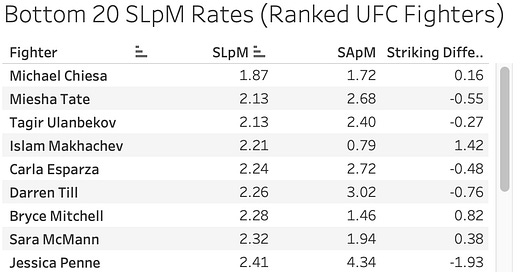Who has the edge in negative striking differential battle between Miesha Tate and Ketlen Vieira?
Neither Miesha Tate nor Ketlen Vieira are going to light the world on fire with their striking numbers. Tate’s 2.13 significant strikes landed per minute rate is the second lowest among ranked fighters. The only currently ranked fighter with a lower striking rate is Michael Chiesa (1.87). Vieira’s rate is only slightly better at 2.66.
Vieira has been a little less sound defensively and therefore has the lower striking differential. In fact there are only seven ranked fighters with a striking differential worse than Vieira. At the moment, there are only 43 ranked fighters with a negative differential and two of them are in the main event on Saturday night.
Part of the dearth of positive striking numbers is due to style. Both of these fighters are at their best when they are holding control positions along the fence and working from the top position. This is especially true for Vieira. She has held control positions for 39.82% of her total cage time. Vieira has won only once in the UFC when she had less control time than her opponent, her submission win over Sara McMann, and she has finished with over eight minutes of control in three of her seven UFC fights.
With two fighters who like to control position, the fight could potentially play out two ways. First, one fighter claims positional dominance and then has a vintage performance. Second, neither fighter is able to control position, and the fight turns into a distance striking contest.
If the fight does play out at distance, it would appear to favor Tate. Vieira has been outlanded in the position in five of her seven UFC fights. Even after taking an extended hiatus from MMA, Tate returned and had perhaps her best distance striking performance of her UFC career, Against Marion Reneau she landed 2.69 significant strikes per minute, while absorbing 1.26 for a distance differential of +1.43. It was her highest distance strikes landed per minute rate and distance differential since her 2010 Strikeforce victory over Maiju Kujala, which was oddly only a six-minute decision. (Even though the Kujala bout was part of a strange one-night tournament, it is never a bad opportunity to reflect on the idiocy associated with women fighting bouts with only three three-minute rounds. This article from superstar Dr. Johnny Benjamin might be the height of said idiocy)
Vieira’s best path to win appears to be through her wrestling. If she is able to score takedowns, she should be able to maintain position and win rounds. In her UFC career, she has landed 2.19 takedowns per 15 minutes, which is above the average for a ranked fighter (1.53). While Tate has similar offensive takedown numbers (2.16 takedowns per 15 minutes), she has had trouble against fighters who want to drag her to the floor. She has allowed her opponents to land 1.39 per 15 minutes, which is below the average for ranked fighters (1.14).
The good news for Tate is that Vieira has not really been an effective striker in the clinch and on the ground. Despite spending a large portion of her cage time in control positions, she has a negative striking differential in the clinch and on the ground. For example, in Vieira’s last fight against Yana Kunitskaya, she was able to rack up a whopping 8:38 of control time in the 15-minute fight. However, she was outlanded 21 to four in terms of significant clinch strikes and 18 to zero on the ground.
If Vieira fails to establish position on the ground and in the clinch, she will likely struggle to outland Tate at range. If she spends time working for takedowns, she opens up opportunities for Tate to land against her in those positions. On top of that, this is a 25-minute fight, which makes winning a decision via position that much harder.





